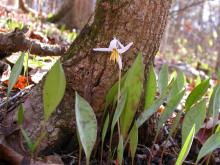Wildflowers, Grasses and Other Nonwoody Plants
Media

Species Types
Scientific Name
Liatris aspera
Description
Rough blazing star is fairly common and scattered nearly statewide. To distinguish between Missouri’s nine species in the genus Liatris, start by noting details of the flower structure. It’s not hard when you know what to look for.
Media

Species Types
Scientific Name
Cichorium intybus
Description
In summer and fall, the pretty blue flowers of chicory decorate roadsides and other disturbed areas. This weedy member of the aster family was introduced from Europe long ago. Its roots have been used as a coffee substitute.
Media

Species Types
Scientific Name
Centaurea stoebe
Description
Spotted knapweed is an invasive plant that outcompetes native communities, takes over pastureland, and even beats back invasive sericea lespedeza! It has arrived in our state. Let’s prevent its spread.
Media

Species Types
Scientific Name
Conoclinium coelestinum (formerly Eupatorium coelestinum)
Description
Mist flower, or wild ageratum, is a vigorous native perennial bearing fluffy-looking, bluish-purple flowerheads. It looks quite a bit like the annual ageratum that is sold as a bedding plant in garden centers.
Media

Species Types
Scientific Name
Oenothera speciosa
Description
A low-growing wildflower that can colonize large areas along roadsides, showy evening primrose bears pink or white flowers that seem too large for the vegetation that supports them.
Media

Species Types
Scientific Name
Ruellia strepens
Description
Although the funnel-shaped, 5-lobed flowers look something like the petunias you find at garden centers, our wild petunia is not related to them. This ruellia often has crinkled hairs in 2 narrow, lengthwise bands on opposite sides of the stalk.
Media

Species Types
Scientific Name
Arisaema dracontium
Description
What could be cooler than finding a green dragon? This leafy green plant with a long, noodly spadix is closely related to Jack-in-the-pulpit. It occurs in the same habitats but is less common and easily overlooked.
Media

Species Types
Scientific Name
Podophyllum peltatum
Description
Mayapple is a common spring wildflower that makes its biggest impression with its leaves, which resemble umbrellas arising from a single stalk. It often grows in colonies.
Media

Species Types
Scientific Name
Perilla frutescens
Description
Introduced as an ornamental, beefsteak plant is native to Asia. It is common in moist or dry wooded bottomlands, open valley pastures, and along trails, railroads, and roadsides. It spreads invasively in our state.
Media

Species Types
Scientific Name
Erythronium albidum
Description
White dogtooth violet, or white trout lily, is a small, early blooming lily that lives in wooded areas. Its flowers are white and its narrow leaves are purplish or brownish mottled. They are often found as a colony of blade-shaped, green-and-brown-mottled leaves poking out of the earth in spring, with only a few producing flowers.
See Also
About Wildflowers, Grasses and Other Nonwoody Plants in Missouri
A very simple way of thinking about the green world is to divide the vascular plants into two groups: woody and nonwoody (or herbaceous). But this is an artificial division; many plant families include some species that are woody and some that are not. The diversity of nonwoody vascular plants is staggering! Think of all the ferns, grasses, sedges, lilies, peas, sunflowers, nightshades, milkweeds, mustards, mints, and mallows — weeds and wildflowers — and many more!





















